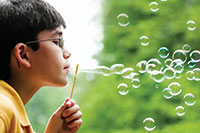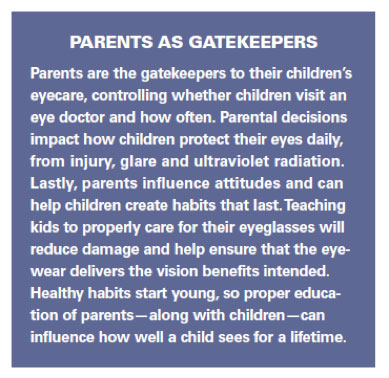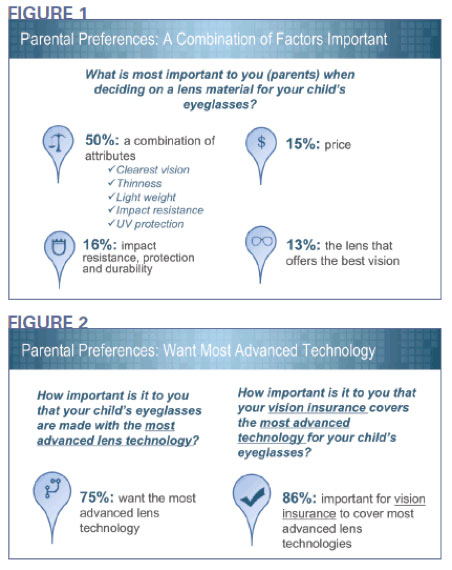
Ever wonder who's more nervous—the child who's getting their first pair of glasses, or the patient's parent? It turns out that when faced with a new eyewear prescription for their child, parents often have concerns that they don't necessarily know how to express. After all, most consumers know little about eyewear other than there are lots of styles, lenses are a mystery and they're not sure what they should cost. Add to this apprehension over having to protect such an important investment, and it's easy to see how overwhelming the situation can become.

To better understand the concerns of parents and how they're being addressed by eyecare professionals (ECPs), PPG Industries commissioned a survey of 500 U.S. adults in March 2012. The goal of the research was to learn how to better engage with today's parents to promote a child's vision as well as understand parent's expectations.
The results of the PPG survey showed that parents do feel that eyecare professionals could play a greater role in two major ways. First, ECPs should educate parents and their children on lens options that provide better solutions for the way that children use their glasses. Second, there is an essential need for children to better understand how to care for their eyewear.
EYEWEAR ATTRIBUTES—PARENTAL OPINION
We all know that kids' eyewear needs are different from those of adults, but parents' perspectives often influence how well those needs are met. In this and the following sections, we'll compare the results of the survey and the ways that an ECP can deliver a variety of options and solutions for every child and his/her parents.

Parents were asked to pick what was most important to them when deciding on a lens material for their child's eyeglasses. About half felt that a combination of lens attributes (clearest vision, thinness, light weight, impact resistance and UV protection) was the most important. The remaining three attributes were about equally important, i.e., 13 percent said they would always choose the lens that offers the best vision, while 15 percent said price was their primary concern, and 16 percent picked impact resistance, protection and durability (Fig. 1).
When asked about the importance of technology, 75 percent agreed it is important to them that their child's eyeglasses are made with the most advanced lens technology, while 86 percent of respondents said it is important to them that their vision care insurance plan covers the most advanced lens technologies for their child's eyeglasses (Fig. 2).
EYEWEAR ATTRIBUTES—PROFESSIONAL OPINION
At a professional roundtable event hosted by PPG and partner Hoya Vision Care North America, experienced eyecare professionals weighed in on the factors that they believe should be parental considerations. As it relates to frames, they recommend frames that kept their adjustment are well-constructed and feature spring hinges. For lenses, they recommend lenses that perform well across a spectrum of features, not simply offering impact resistant lenses and ending the education and recommendation process there.
If eyecare professionals don't take the time to explain to the parent about what qualities to look for in frames, lens material and lens design, in their eyes these products are just commodities. Unless ECPs take the time to talk about the difference in the lenses that come out of our practices, all lenses are equal in the parent's eyes. But once they understand the importance of children-designed frames and the right lenses, parents are empowered to make a decision that is based on more than just price and insurance coverage.
To ensure compliance with wearing the eyeglasses, there has to be a balance between parental and child preferences. For example, a parent who chooses a bright red or blue frame should not be surprised when the child does not want or like to wear their glasses. It may simply be the color. But clearly the decision should not be solely left up to the child either. It is important to engage both parties—the parent and the child—in order to help realize a visual solution that works well.
Children will also be reluctant or refuse to wear their glasses if they're experiencing distortion and/or discomfort. Lenses should be safe, clear and comfortable to wear.

Safe—Safety encompasses protection from impact, scratches and ultraviolet radiation. While all lenses are considered as "medical devices" and must meet standards for impact resistance as required by the U.S. Food and Drug Administration (FDA 21CFR801.410, commonly referred to as "the drop-ball test"), children require lenses that significantly exceed the FDA standard. For many practices, they have added Trivex material lenses as an alternative to polycarbonate for impact, absorption and clear prescription properties. The roundtable participants pointed out that in addition to safety and extreme impact resistance, lenses must be 100 percent UV-absorptive. In addition, lens finishing (i.e., beveling) requires that the lens be held firmly in a child's frame. If the bevel gets rounded, for example by hand polishing after edging, the ability for the bevel to hold firmly is diminished. As a result, be sure that your lab produces crisp edges for the best lens retention.
Clear—Corrected vision delivered with the utmost clarity is always the goal. With children, this is even more critical because during their first 12 years, visual learning accounts for 80 percent of the learning process. Visual clarity of a lens begins with the material's fundamental ability to effectively align the spectrum of light waves that pass through it. Abbe value is an indicator of the amount of dispersion or chromatic aberration of a lens material—the higher the Abbe value, the lower the chromatic aberration and clearer the vision for the wearer (all other factors being equal). Trivex material has an Abbe value of 43-45 (depending on lens manufacturer). But clear vision does not stop at Abbe value. Lens designs and anti-reflective coatings also contribute to clearer, edge-to-edge vision. Combining digitally-enhanced lenses with the best AR coatings and high Abbe materials help to provide lenses with minimal distortion, especially in higher prescriptions. No parent would ever want to sacrifice their child's vision, so this presents an opportunity to discuss the value versus cost of eyewear, encouraging them to provide the best vision with their children's eyewear.
Comfortable—Comfort is a frame and lens combination. Frame bridge design must match the child's nose bridge shape. For adjustable nosepads, rounded and silicone pads are recommended so they don't dig into the skin. For a saddle bridge, the nosepads are splayed more so they better fit the flatter and wider surface area of the nose bridge, especially for smaller children.
Lens comfort is also related to final lens weight, which is a function of refractive index, specific gravity, lens size (frame eye size) and lens processing thickness. Trivex material provides a good balance of these factors with a refractive index of 1.53, a specific gravity of 1.11 g/cm3, and the ability to process Trivex lenses to thin centers. In fact, Trivex material has the lowest specific gravity of all prescription lens materials (Trivex material, 1.11g/cm3). In addition to frame fit and lens weight, photochromics provide the comfort and convenience of adjusting from clear indoors to dark outdoors. Trivex material is available in Transitions and other photochromic lenses.
To take the American Board of Opticianry (ABO) certified test related to this topic, please click here.












